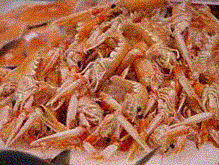Crustaceans
Crustaceans is a generic term including all arthropodic aquatic animals. They are divided into six major subgroups that include 44,000 species. Hypersensitivity reactions to ingested crustaceans, such as shrimp, lobster, langoustine, crayfish and crab count among the most frequent causes of food-induced allergic reactions, and crustacea are the third most important cause of food induced anaphylaxis. Allergies towards crustaceans commonly appear at a later stage of life, and are not likely to be outgrown.
Symptoms most often occur when the seafood is ingested, but can also appear when raw seafood is handled and after inhaling steam. Allergic reactions in workers involved in seafood processing also occur and are a serious public health problem in countries with major shellfish industries.
Tropomyosin – the ubiquitous crustaceanous allergen
The dominant allergen in the different crustaceans is the muscle protein tropomyosin (e.g. Pen a 1 in Brown shrimp (Penaeus aztecus)), which has been identified in 21 crustacean species to date and is responsible for about 80 % of all shrimp-related allergic incidents. A second potential cross-reactive allergen, arginine kinase, was described in Tiger shrimp (Pen m 2) (Penaeus monodon) and Pacific white shrimp (Lit v 2) (Litopenaeus vannamei). Myosin (Lit v 3) and sarcoplasmatic Ca-binding protein (Lit v 4) are considered minor allergens.
Tropomyosin is a conserved protein, and homologues in different species show a considerable rate of identity. As a consequence, someone with allergy to tropomyosin from one kind of crustacean is likely to react to others due to extensive cross-reactivity 75 % probability). Additionally, cross-reactions to insects like cockroaches, house dust mites, midges, and moths are not unusual. Tropomyosin is considered a possible cause for cross-reactivities between food and respiratory allergens of animal origin. Furthermore, cross-reactions to molluscean species, brine shrimp (Artemia salina), and fish parasites like the cod worm (Anisakis simplex) have been observed. Tropomyosin is a rather stable protein, which allergenicity is not removed by heating and digesting.
Case report from the Norwegian Food Allergy Register
Severe allergic reaction to hidden shellfish protein in a fish cake.
A patient experienced an anaphylactic incident after having eaten a particular brand of fish cake. The fish cake sample, protein extracts from several fishes and shellfishes, and purified cod parvalbumin and shrimp tropomyosin were analysed by dot and Western blots, using patient and control sera. The major shellfish allergen tropomyosin was recognized in the fish cake extract.
Our study encouraged the manufacturer of the fish cake to intensify the washing between different product batches, as the hidden allergen could be tracked down to cross-ontamination by a shellfish pastry produced on the same manufacturing line.
See publication in Allergy
Development of a quantitative sandwich ELISA for the determination of tropomyosin from crustaceans in foods
A quantitative sandwich enzyme-linked immunosorbent assay (ELISA) for the detection of tropomyosin from crustaceans in foods has been developed and validated. A polyclonal rabbit antitropomyosin capture antibody and the biotinylated conjugate of the same antibody for detection were the basis for the ELISA, which was specific for crustaceans. The ELISA was able to quantitate tropomyosin in various food matrixes, had a detection limit of 1 microg/g, and cross-reacted to some extent with cockroach. Recoveries ranged from 63 to 120%, and the intra and interassay coefficients of variation were <6 and <14%, respectively.

Development of a Rocket Immunoelectrophoresis Assay (RIE)
In cooperation with the Swedish National Food Administration, a RIE was developed using anti-shrimp tropomyosin antibodies. It allowed the specific detection of > 20 mg/kg crab in a surimi product (fish-based imitation crabstick product).